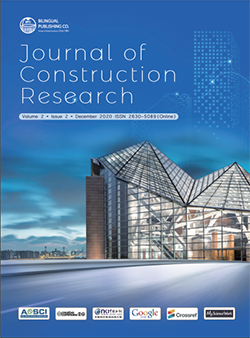Flexural Behavior of 3D Printed Concrete Beam with Fiber Reinforcement
DOI:
https://doi.org/10.30564/jcr.v2i2.2823Abstract
3D printing with concrete is a promising new method for rapid, low cost construction. The flexural strengths for reinforced/unreinforced and 3D printed/cast concrete Warren trusses were tabulated and the failure mechanisms were reported. The types of reinforcement used were rebar(basalt and steel), and mesh (basalt and aramid). The effect of loading geometry and loading speed was measured for basalt mesh and aramid mesh composite, respectively. Due to the expected variation in flexure between samples, it cannot be said whether small differences for various tests are significant. Variation stems from a microscopically uneven surface and random inhomogeneities in the bulk of the tested material which act as a microcrack catalyst and propagator. Since the tested beams are short specimens the numerical findings of other studies will vary based on the intended design. This paper is intended to assess the performance of various reinforcements in a qualitative sense by comparing basalt reinforcement with other reinforcements. It was found that cast beams tolerated deflection better but had a similar flexure strength compared as the printed beams. The steel and basalt rebar reinforced beams had the highest flexure strengths where the traditional steel rebar reinforcement outperformed the basalt in flexure by 36% and the basalt outperformed the steel in deflection by 40%. The basalt mesh outperformed the cast and printed unreinforced bars by a small margin but had only 25% of steel rebars’ deflection at maximum flexure strength. The aramid mesh tolerated the biggest deflection out of any sample at 2.26 cm.
Keywords:
3D printing, Large scale, Basalt rebar, Aramid mesh, Flexure strength, Concrete, Warren trussReferences
[1] G J Gibbons, R Williams, P Purnell & E Farahi (2010) 3D Printing of cement composites, Advances in Applied
[2] Ceramics, 109:5, 287-290, DOI:10.1179/174367509X12472364600878
[3] Joseph Pegna, Exploratory investigation of solid freeform construction, Automation in Construction, Volume 5,
[4] Issue 5, 1997, Pages 427-437, ISSN 0926-5805, https://doi.org/10.1016/S0926-5805(96)00166-5.
[5] Khoshnevis, Behrokh. "Automated construction by contour crafting—related robotics and information technologies.
[6] " Automation in construction 13.1 (2004): 5-19.
[7] Le, Thanh T., et al. "Mix design and fresh properties for high-performance printing concrete."
[8] Materials and structures 45.8 (2012): 1221-1232.
[9] ASTM C78 / C78M, 2016, “Method for Flexural Strength of Concrete (Using Simple Beam with Third-Point Loading),” ASTM International, West Conshohocken, PA, 2016, Available at: https://compass.astm.org/EDIT/html_annot.cgi?C78+18 [Accessed 23 Jul. 2019].
[10] DuPont (2017). Technical Guide: KEVLAR Aramid Fiber. [EBook] Richmond: DuPont. Available at: https://www.dupont.com/content/dam/dupont/products-and-services/fabrics-fibers-and-nonwovens/fibers/documents/Kevlar_Technical_Guide.pdf [Accessed 23 Jul. 2019].
[11] European Patent Office (2019). Method and apparatus for production of three-dimensional objects by stereolithography. EP0171069.
[12] Li, H., Xian, G., Xiao, B. and Wu, J. (2010). Comprehensive Characterization of BFRP Applied in Civil Engineering. Springer, Berlin, Heidelberg.
[13] Mindess, S., Young, J. and Darwin, D. (2008). Concrete. Taipei: Pearson Education Taiwan (p28)
[14] Mechtcherine, Viktor, et al. "3D-printed steel reinforcement for digital concrete construction–Manufacture, mechanical properties and bond behaviour." Construction and Building Materials 179 (2018): 125-137.
[15] (“Design Guide: Selective Laser SIntering (SLS) version 2.1,” n.d.)
[16] Al-Chaar, G., Case, P., Northrop, G., Kreiger, M., n.d. Printable Concrete Composition. US patent Pub. No. 2018/0057405 A1
[17] Bos, Freek P., et al. "3D printing concrete with reinforcement." High Tech Concrete: Where Technology and Engineering Meet. Springer, Cham, 2018. 2484-2493.
[18] Asprone, Domenico, et al. "3D printing of reinforced concrete elements: Technology and design approach." Construction and Building Materials 165 (2018): 218-23
[19] X.X. Zhang, A.M. Abd Elazim, G. Ruiz, R.C. Yu, Fracture behaviour of steel fibre-reinforced concrete at a wide range of loading rates, International Journal of Impact Engineering, Volume 71, 2014, Pages 89-96, ISSN 0734-743X,
Downloads
Issue
Article Type
License
Copyright and Licensing
The authors shall retain the copyright of their work but allow the Publisher to publish, copy, distribute, and convey the work.
Journal of Construction Research publishes accepted manuscripts under Creative Commons Attribution-NonCommercial 4.0 International License (CC BY-NC 4.0). Authors who submit their papers for publication by Journal of Construction Research agree to have the CC BY-NC 4.0 license applied to their work, and that anyone is allowed to reuse the article or part of it free of charge for non-commercial use. As long as you follow the license terms and original source is properly cited, anyone may copy, redistribute the material in any medium or format, remix, transform, and build upon the material.
License Policy for Reuse of Third-Party Materials
If a manuscript submitted to the journal contains the materials which are held in copyright by a third-party, authors are responsible for obtaining permissions from the copyright holder to reuse or republish any previously published figures, illustrations, charts, tables, photographs, and text excerpts, etc. When submitting a manuscript, official written proof of permission must be provided and clearly stated in the cover letter.
The editorial office of the journal has the right to reject/retract articles that reuse third-party materials without permission.
Journal Policies on Data Sharing
We encourage authors to share articles published in our journal to other data platforms, but only if it is noted that it has been published in this journal.




 Ghassan K Al-Chaar
Ghassan K Al-Chaar

